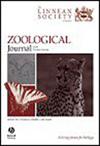小蜣螂筑巢行为的分子系统发育及体型相关趋同进化(鞘翅目:金龟子科:金龟子科)
IF 2.8
2区 生物学
Q1 ZOOLOGY
引用次数: 0
摘要
aphhodiini Leach大约有2200个物种。这种巨大的多样性被认为是由于它们专门以各种各样的碎屑为食,尤其是哺乳动物的粪便。尽管它们具有多样性和作为分解者的生态作用,但这一群体的进化过程和生态特征在很大程度上仍然未知。因此,本研究旨在利用综合的多基因数据集(COI, 16S, 28S和18S)和生态数据,重建蚁科蚁群的第一个分子系统发育,并探索蚁族蚁巢行为的进化史。我们的分析恢复了Aphodiinae类群的单系性,而揭示了Psammodiini类群的旁系性,Aphodiini和Eupariini类群的多系性。阿佛迪尼的系统发育位置表明,这个主要是食腐动物的谱系起源于广泛的食腐动物谱系。巢巢行为的祖先状态重建表明,阿佛狄尼干群以非巢巢为主,其他巢巢行为在属或种水平上独立进化。值得注意的是,体型较大的分类群已经进化出了一种准天敌策略,这种策略似乎在粪块的种间和种内资源竞争中都具有优势。相比之下,小体型与盗贼行为无关,但这种行为可能会根据环境条件而变化。我们的研究结果为小型蜣螂的进化史提供了新的见解,特别是强调了与体型有关的食粪阿佛迪尼筑巢行为的趋同进化。本文章由计算机程序翻译,如有差异,请以英文原文为准。
Molecular phylogeny and body size-related convergent evolution of nesting behaviour in small dung beetles (Coleoptera: Scarabaeidae: Aphodiinae)
Aphodiini Leach comprises approximately 2,200 species. This great diversity is thought to derive from their specialization in feeding on a wide variety of detritus, particularly mammal dung. Despite their diversity and ecological role as decomposers, the evolutionary processes and ecological traits in this group are still largely unknown. Therefore, the present study aims to reconstruct the first molecular phylogeny of the Aphodiinae group and to explore the evolutionary history of nesting behaviours within the coprophagous tribe Aphodiini, utilizing a comprehensive multi-gene dataset (COI, 16S, 28S, and 18S) with ecological data. Our analyses recovered the monophyly of the Aphodiinae group, while revealing paraphyly in Psammodiini, and polyphyly in Aphodiini and Eupariini. The phylogenetic position of Aphodiini suggests that this largely coprophagous lineage derived from broad detritivore lineages. Ancestral state reconstruction of nesting behaviour revealed that the stem group of Aphodiini was predominantly non-nesting, with other nesting behaviours evolving independently at the generic or species’ levels. Notably, larger-bodied taxa have evolved a paracoprid strategy that appears to confer advantages in both inter- and intraspecific resource competition at dung pats. In contrast, small body size does not associate with kleptocoprid behaviour, but this behaviour might be more variable depending on environmental conditions. Our results offer new insights into the evolutionary history of small dung beetles, particularly highlighting the body size-related convergent evolution of nesting behaviour in coprophagous Aphodiini.
求助全文
通过发布文献求助,成功后即可免费获取论文全文。
去求助
来源期刊
CiteScore
6.50
自引率
10.70%
发文量
116
审稿时长
6-12 weeks
期刊介绍:
The Zoological Journal of the Linnean Society publishes papers on systematic and evolutionary zoology and comparative, functional and other studies where relevant to these areas. Studies of extinct as well as living animals are included. Reviews are also published; these may be invited by the Editorial Board, but uninvited reviews may also be considered. The Zoological Journal also has a wide circulation amongst zoologists and although narrowly specialized papers are not excluded, potential authors should bear that readership in mind.

 求助内容:
求助内容: 应助结果提醒方式:
应助结果提醒方式:


